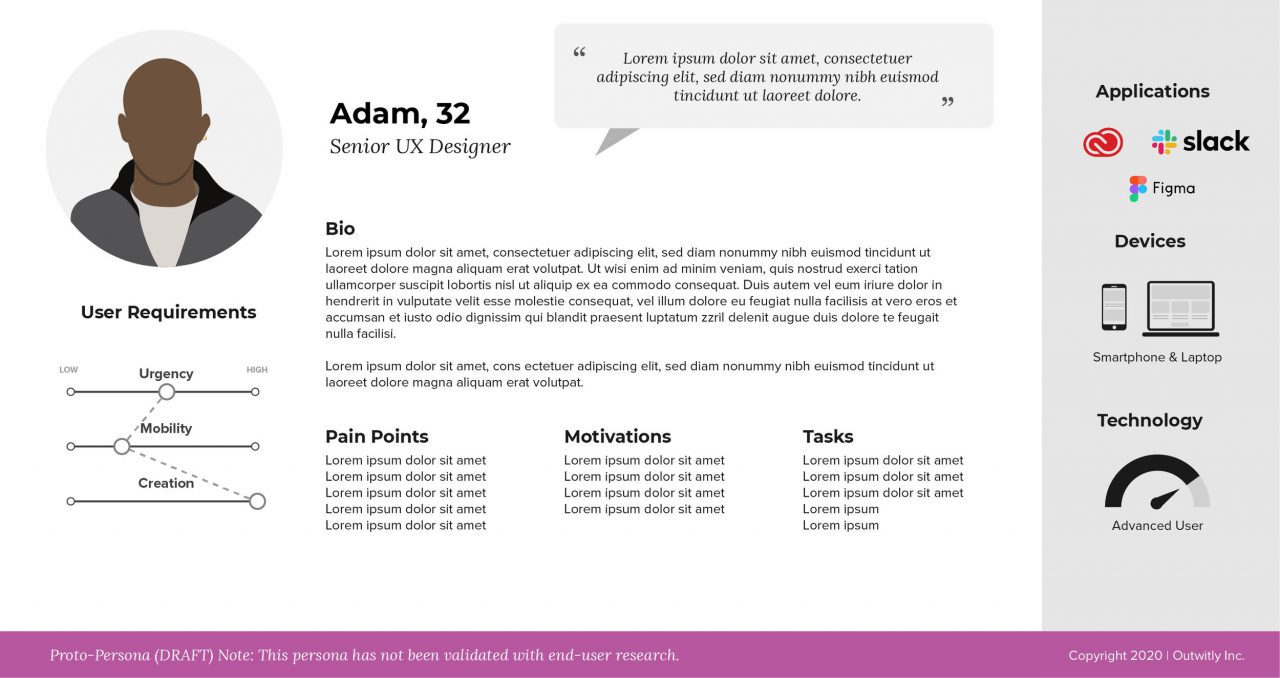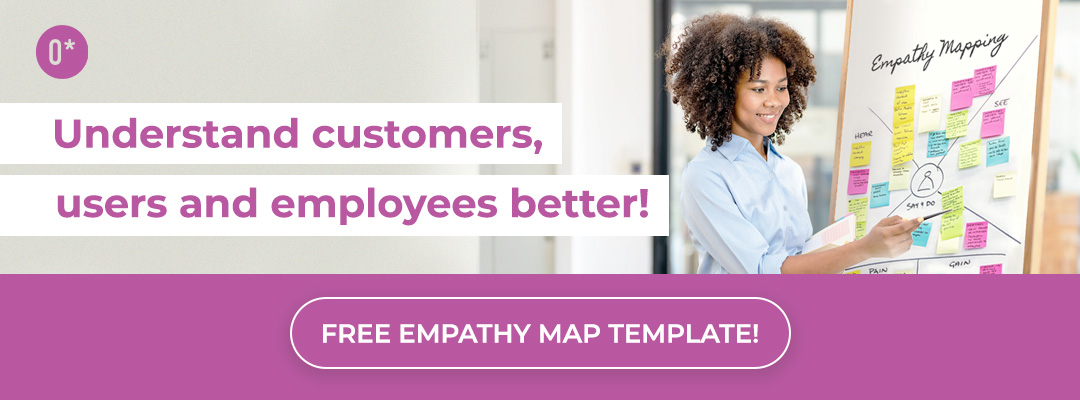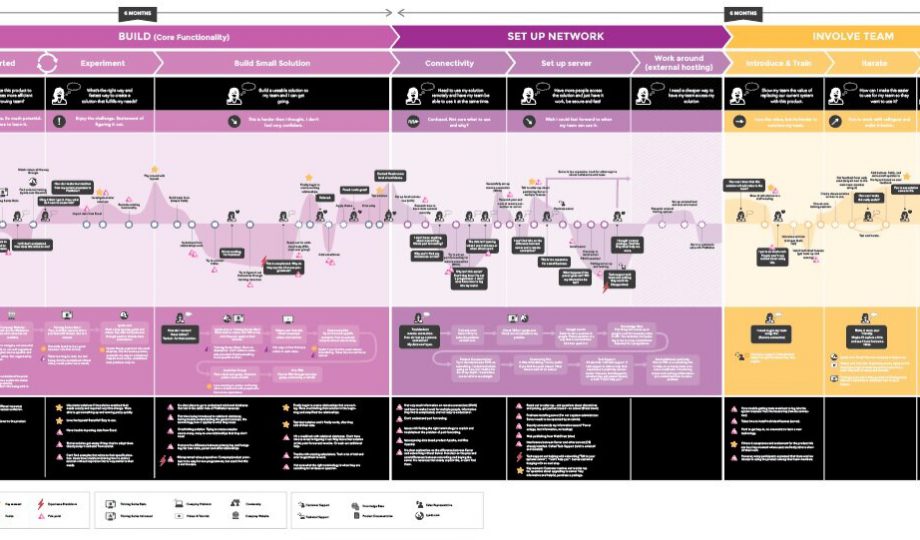Creating a proto persona is the perfect activity for when you don’t have the time or money to conduct research with real end-users, but you still want to start implementing human-centered design (HCD) best practices at your organization. While we always advocate for conducting research with users, we also understand how difficult it can be to get research prioritized… especially if you’re busy putting out fires and responding to product and/or engineering requests, working with limited resources, and/or operating within a company with low UX maturity.
This blog post will take you through everything you need to know about proto personas so you start empathizing with users, get buy-in for real research, and help your organization dip their toes into HCD!
Here’s what we’ll cover:
- Proto Persona Definition and Example
- Empathy Maps vs Personas
- Proto Personas Template
- How Not to Use Proto Personas
Let’s get into it.
What is a proto persona?
A proto persona is a preliminary profile/archetype informed by the current understanding of a user group or customer segment’s characteristics, background, motivations, tasks and pain points. It’s a design tool that you can use now to help colleagues/stakeholders empathize with your users when user research projects are not possible… and start to gain buy-in for future research!
What are the key benefits of proto personas?
Proto personas can:
- Help ensure that products are designed with a persona in mind
- Remind team members/stakeholders that they are not “the user”
- Serve as beacons or guides to keep your project team aligned
- Serve as tie-breakers when product decisions are at a stand-still
- Help to prioritize features and goals (i.e. what problems to solve first)
- Increase the quality, value and consistency of products and related experiences (This is the big one!!)
All of the benefits of personas are achieved through empathy. It’s surprisingly easy to forget that designers and stakeholders are not the end-users and can’t read their minds. To design effective products and services, empathy is crucial. It helps us get at what real users actually want and need.
What is the difference between a persona and a proto persona?
A persona is a customer/user archetype based on ethnographic research, while a proto persona is a preliminary version that is built based on existing, incomplete knowledge. “Proto” is Greek for “first,” signifying that a proto persona is a less evolved (but still useful!) iteration of a persona… It’s the same idea as the word “prototype/prototyping.”
Proto personas are based on the assumptions of team members and stakeholders and should be further checked against data from discovery research with users, like in-depth interviews and contextual observations. They’re handy benchmarks for aligning stakeholders, but they only go so far as to represent who stakeholders think their users are, what they like, and so on. We always recommend that real user personas be developed at some point.
Proto Persona Example
Below is an example of a proto persona. Proto personas generally contain the same features:
- Name
- Bio (A description of the user’s relevant background)
- Demographic information (Gender, age, occupation, etc.)
- Pain Points (Their daily challenges)
- Motivations or Goals (What do they care about? What are they trying to achieve?)
- Tasks (Which activities do they undertake in the context of your product/service?)
- Technology Expertise (Low, medium, or high)
Empathy Map vs Persona
An empathy map displays a user group’s thoughts, feelings and actions when in a specific circumstance, while a persona is a representative user archetype that includes background details and fixed traits. Empathy maps are often co-created with stakeholders and/or users as a form of generative research, and true personas are built off of research data. It’s common to use empathy maps as data sources for building personas. Of course, as we mentioned earlier in this blog post, proto personas are not built from formal research.
(Note: Want to try out an empathy map workshop with your team? Download a free empathy mapping template below.)
Proto Personas Template
When it comes to building proto personas, using a template can help you get moving sooner and avoid missing crucial pieces.
Steps to Building a Proto Persona
Two key steps we recommend for crafting strong proto personas include talking to proxy users, holding a workshop with stakeholders/team members, and incorporating empathy mapping.
Here are our recommended high-level steps for building proto personas:
- Interview/talk to proxy users
- Set up your templates
- Set up a workshop for empathy mapping and persona creation
- Invite stakeholders and team members
- Break participants into teams
- Assign each team one persona (Often 4-6; depending on your user groups)
- Build proto personas in collaboration
- Ask each team to fill out an empathy map
- Reassemble the group and discuss/validate each map
- Ask each team to build their proto personas based on their empathy maps
- Review the proto personas with stakeholders
- Update your personas post-workshop
Proxy users are people in your organization who are not users, but are “close enough” (for now) to the user you’re studying and can serve as substitutes (e.g. they have a lot of product knowledge or may support real users as part of their job). For your interviews with them, focus on questions like: “What are the different user groups or categories?”; “What are their biggest challenges?”; “What are the characteristics that make these user groups similar or different to one another?” and so on.
As for workshop attendees, consider inviting three tiers of team members: 1) front-line workers or customer support people who interact with customers daily; 2) delivery team workers (the people who will actually design and develop the product/service); and 3) management and executives (both product and marketing). After all, this is an exercise about building empathy for users and gaining buy-in from higher-level stakeholders.
Template Resources for Proto Personas
Here are some of our favourite resources for proto persona templates:
- MIro proto persona templates — The “sticky” note approach works so well for team collaboration.
- Figma proto persona templates — If your team already spends a lot of time in Figma, why not introduce another workflow?
- Canva user persona templates — Less of a collaboration tool, but you can use these as jumping-off points for your proto personas, or to finalize them after a workshop.
How Not to Use Proto Personas
Proto personas should NEVER be mistaken as real, data-backed personas… just as proxy users should never be seen as be-all, end-all replacement for actual users in your research. Since proto personas are not built from real user research data, they may be lacking critical details, or they could be just plain wrong in some cases.
We recommend validating them with real users, or using the proto personas as proof of concept with your stakeholders to launch a real research study. In other words, demonstrate why personas are valuable, and make a business case for why backing them up with research would be even more valuable.
You should ideally keep your proto personas in draft format ONLY, and clearly labelled as proto personas. You do NOT want these to appear as “final” because then there may be no incentive to conduct real user research to back them up. Consider including an additional slide/page that includes the questions that remain answered.
At the end of the day, investing in user research is incredibly valuable, and that value is irreplaceable. BUT, if real research is just not possible, building personas is a great way to get your project team started on the right path toward a human-centered design approach and open up conversations that lead to buy-in for real and impactful user research.
Other resources we like….
- UX Maturity Scales by the NNGroup
- Creating Proto Personas with UX Collective
- What’s the Problem with Proxy Users?
PS: If you liked this post, you should sign up to get our Weekly Wit newsletter. We have thousands of subscribers and very high open rate because we deliver only the best tips from real practitioners:







